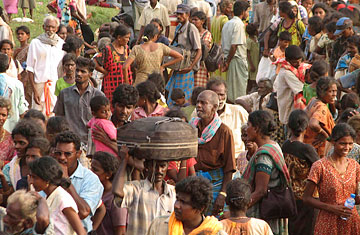
Sri Lankan civilians evacuated from the northern war zone wait at a camp about 230 km north of Colombo on April 21
Twice the size of Central Park. That was the answer U.N. humanitarian chief John Holmes gave in early April when asked how large the area was where more than 100,000 civilians were trapped with bloody battles raging around them in northern Sri Lanka. This week, that small area was reduced by a quarter when government forces gained control of a 3-km stretch of the 12-km coastal sliver that had once been a stronghold of the Liberation Tigers of Tamil Eelam (LTTE).
As troops drove the Tigers deeper into their fast-shrinking zone, since Monday, some 90,000 civilians who had been cornered there since February have broken free and crossed the front lines to safety, according to the Defense Ministry. On the morning of April 20, the army pierced a fortified earth bund manned by armed Tigers, allowing trapped civilians who had been held back by the Tigers to escape. On the run for over a year and having experienced multiple displacements, those desperate civilians finally walked to safety through the shallow waters of Mulaithivu lagoon, carrying the injured, the weak and the young. Most made the crossing with only the ragged clothes on their bodies. The army reported that the Tigers had fired at the fleeing civilians and said 17 people were killed and more than 200 injured when three suicide bombers detonated themselves among the fleeing civilians on April 20. Despite the obvious dangers of the flight, more are expected to follow. The army was anticipating that at least another 10,000 would make the crossing on Wednesday. (Read a brief history of the Tamil Tigers.)
Remaining within the tiny but bloody battlefield would be nothing short of courting suicide. "We're seeing the final stage of this war, with the government determined to wipe out the Tigers' control of Sri Lankan territory once and for all, and the Tigers using every means to resist them," warned Gordon Weiss, a U.N. spokesman in Colombo. "Tragically, tens of thousands of civilians remain caught between those two ambitions." While welcoming the mass escapes, the U.N. has raised alarms over the safety of as many as 100,000 people, all ethnic Tamils, who are still trapped behind Tiger lines. U.N. Secretary-General Ban Ki-moon has repeatedly called on both sides to ensure the safety of the civilians and asked the Tigers to allow the civilians to leave the combat zone freely. The last such call came on April 20.
The International Committee of the Red Cross (ICRC), which has been evacuating the sick, the wounded and their caregivers by sea, says the situation within the combat zone is extremely dire. "The humanitarian situation within the conflict area is catastrophic," Sarasi Wijeratne, an ICRC spokesperson, told TIME. For the civilians who have survived in the area since February, when the land links into the combat zone were closed due to fighting, there is only one makeshift hospital in the area under Tiger control — and that, too, is under tremendous pressure. The ICRC has evacuated more than 10,000 civilians from the war zone since February, and the Green Ocean, an ICRC-flagged ship that has been making the precarious journey, headed back on the morning of April 22 to rescue yet another batch of injured and scared civilians. The journey was delayed when the army gained control of the area where the ship usually anchored, and the Tigers gave the ICRC new coordinates. "We have obtained security guarantees from both sides," Wijeratne said. The ship, however, was not carrying food supplies as it had on some of its journeys. (Read about the Tigers' leader, Velupillai Prabhakaran.)
The U.S. State Department also warned of a deteriorating situation within the combat zone. "There continues to be firing from both sides into the no-fire zone, and we have credible reports of increasing casualties as a result of intensified military actions," Robert Wood, acting department spokesman, said on Tuesday. There is unlikely to be any lull in the fighting as the Sri Lanka forces push to dislodge and deal the Tigers — who have been fighting a bloody separatist war since 1976 — a final and telling blow. The military said two divisions had linked up in the area, and the push into the small area where the Tigers are now holed up will intensify. Nine divisions from the army with as many as 50,000 troops are now engaged in the assault on the Tigers, which is backed by air power and a naval blockade. It's the largest concentration of government troops on a single Tiger force. And for the trapped civilians, it would make a world of difference to flee across the firing line rather than remain between the fighting parties and the sea.
Watch a video about civilians caught in Sri Lanka's conflict.
